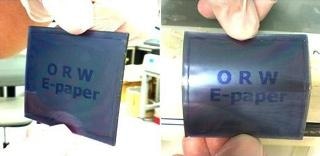Mar 30 2018
A distinctive kind of liquid crystal display (LCD), which is tough, light, flexible, and paper-like, has been developed by optoelectronic engineers from China and Hong Kong. Using this innovation, a daily newspaper can be uploaded onto a flexible paper-like display, which can be updated as fast as the news cycles.
Although it seems to be futuristic, researchers predict that it will be inexpensive to produce, maybe with a cost of just five dollars for a 5-inch screen. The innovative, optically rewritable LCD design has been described in this week’s issue of Applied Physics Letters, published by AIP Publishing.
 This is a combined flexible blue optically rewritable LCD. (Image credit: Zhang et al.)
This is a combined flexible blue optically rewritable LCD. (Image credit: Zhang et al.)
The researchers concentrated on two important innovations for accomplishing highly flexible designs. The first one is the recent advancement of optically rewritable LCDs. Similar to the structure of traditional LCD displays, the structure of this display is sandwich-like, including a liquid crystal filling between two plates.
In contrast to traditional liquid crystals in which electrical connections on the plates produce the fields needed to switch individual pixels from light to dark, in optically rewritable LCDs, the plates are coated with special molecules that get realigned in the presence of polarized light and switch the pixels. This eliminates the need for conventional electrodes, decreases the weight of the structure, and offers more choices in the thickness and type of plates.
As a result, optically rewritable LCDs are considerably thinner than conventional LCDs (with a thickness of only half a millimeter), can be produced from flexible plastic, and have a weight of only a few grams. “It’s only a little thicker than paper,” stated Jiatong Sun, a co-author from Donghua University in China.
Their simple structure makes optically rewritable LCDs inexpensive and robust to produce. In addition, similar to an electronic paper screen in an e-book, energy is needed only to switch text or display images. Hence, running costs are low since these new LCDs avoid the need for power to maintain an image upon being written on the screen.
The second innovation relates to the spacers that separate the glass or plastic plates. “We put spacers between glass layers to keep the liquid crystal layer uniform,” stated Sun. To determine the thickness of the liquid crystal, spacers are used in all LCDs. A constant thickness is mandatory for better contrast ratio, viewing angle, and response time. Yet, when the plates bend, the liquid crystal is forced away from the impact site and makes sections of the screen blank. Hence, changes to spacer design are crucial to prevent excessive movement of the liquid crystal in flexible LCDs. It has been difficult to develop a flexible design that overcomes this barrier.
The scientists trialed three distinctive spacer designs and discovered that a mesh-like spacer blocked the flow of the liquid crystal when the LCD was hit or bent. This innovation allowed them to develop the first flexible, optically rewritable LCD.
One more innovation involved enhanced color rendering. The researchers report that prior to their research, optically rewritable LCDs could display only two colors at a time. At present, their optically rewritable LCD has the ability to display the three primary colors at the same time. They accomplished this by positioning a distinctive type of liquid crystal behind the LCD, which could reflect green, blue, and red. To commercialize this LCD into a product, Sun aims to enhance the resolution of the flexible, optically rewritable LCD.
“Now we have three colors but for the full color, we need to make the pixels too small for human eyes to see,” stated Sun.